Text
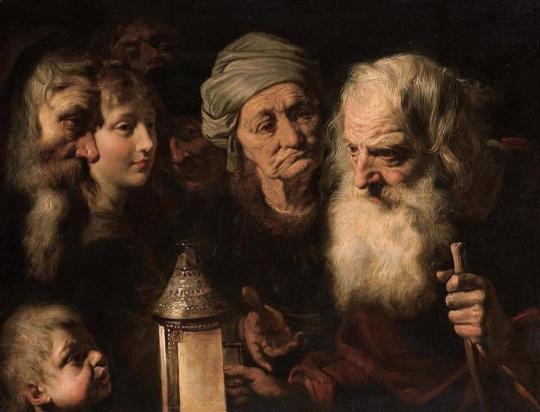
MWW Artwork of the Day (4/25/24)
Pieter van Mol (Flemish, 1599-1650)
Diogenes with his lantern looking for an honest man (c. 1635-45)
Oil on panel, 65 x 84.6 cm.
Private Collection
This arresting Flemish Caravaggesque painting, "Diogenes looking for an Honest Man," is an unrivalled masterpiece from the brush of Pieter van Mol, a relatively unknown artist from the orbit of Rubens in Antwerp. Perhaps the reason for Van Mol’s obscurity is the fact that he spent most of his career working in Paris and not in his native Antwerp. Born nearly eight months after Van Dyck in Antwerp in 1599, Van Mol likely apprenticed with Artus Wolffert and probably accompanied Rubens to Paris in 1625, when the master travelled there for the commission of the Medici Cycle in the Luxembourg Palace. While Van Mol’s oeuvre is replete with paintings of excellent quality, this picture is surely the artist’s strongest work. It was a celebrated treasure in several prominent French collections.
3 notes
·
View notes
Text

MWW Artwork of the Day (4/24/24)
Workshop of Francesco Fanelli (Italian/English, 1577-1639)
David and Goliath (c. 1632-38)
Bronze sculpture, 44.5 x 22.2 x 23.5 cm.
The Metropolitan Museum of Art, New York (Jack & Belle Linsky Collection)
David surmounts Goliath and, bracing one knee on his shoulder, pulls the giant’s head back by the hair as his sword arm stretches to its apogee for the death blow. Goliath is half-risen from the ground, mouth agape, eyes wide but unfocused, with the stone that felled him still “sunke into his forehead” (1 Samuel 17:49). Eschewing the victorious David more frequently represented by Italian artists (from Donatello and Mantegna to Caravaggio), Fanelli chose a moment at the height of action, after David had brought the giant to the ground with his stone and “stood upon” him, sword in hand, to deliver the death blow.
5 notes
·
View notes
Text

MWW Artwork of the Day (4/23/24)
David Jagger (British, 1891-1958)
Olga (1936)
Oil on canvas, 117.5 x 89.5 cm.
Private Collection
In the forward to the 1935 catalogue for the Jagger exhibition at London's Leger Galleries, the critic H. Granville Fell wrote of the artist's work: "Never did a painter's performance speak more clearly for itself. […] There is something plus, and beyond the mere portrait, a decorative quality, an amptitude of line and mass and a harmonious ensemble of color often daringly original, that place them in the higher category of works of art, and this is never the result of flashy accident, but the outcome of much pondering and intelligent brain work."
26 notes
·
View notes
Text

MWW Artwork of the Day (4/22/24)
Caspar Netscher (Dutch, 1639-1684)
A Lady Teaching a Child to Read ('La Maîtresse d'école')(c. 1670-79)
Oil on oak panel, 45.1 x 37 cm.
National Gallery, London
Netscher intends a deliberate contrast between the industry of the girl who is being taught to read and the idleness of the boy, who prefers to play with the dog and knucklebone. On the wall behind is a small copy of Rubens's 'The Brazen Serpent', the original of which is in the National Gallery's Collection. Netscher, who was a portrait and genre painter, trained with Gerard ter Borch, but later his style became strongly influenced by Anthony Van Dyck and his followers in The Hague.
3 notes
·
View notes
Text

MWW Artwork of the Day (4/21/24)
Edgar Degas (French, 1834–1917)
Dancers (1899)
Pastel on paper, 62.2 x 64.8 cm.
The Toledo (OH) Museum of Art (Gift of Edward Drummond Libbey)
The incandescent, expressive colors of Edgar Degas's pastel, "The Dancers," seem to vibrate off the paper. In this and other later works, memory and imagination, "freed from nature's tyranny," as Degas remarked, played a more dominant role than any observed event. Increasingly Degas repeated a shrinking repertory of poses and compositional ideas, obsessively recycling, rephrasing, and regrouping the same few figures studied from the model or from his own photographs or drawings. He also drew inspiration from Japanese prints for The Dancers' high viewpoint and cropped, asymmetrical composition.
7 notes
·
View notes
Text

MWW Artwork of the Day (4/20/24)
Late Medieval India (Vijayanagara Empire, 1336-1646)
Gopuram, Minakshi Temple (1623-55)
Madurai, Tamil Nadu, India
A gopuram is usually rectangular in form with ground-level wooden doors, often richly decorated, providing access. Above is the tapering gopuram, divided into many stories which diminish in size as the gopuram tower narrows. Usually the tower is topped with a barrel vaulted roof with a finial. Gopurams are exquisitely decorated with sculpture and carvings and painted with a variety of themes derived from the Hindu mythology, particularly those associated with the presiding deity of the temple where the gopuram is located.
8 notes
·
View notes
Text
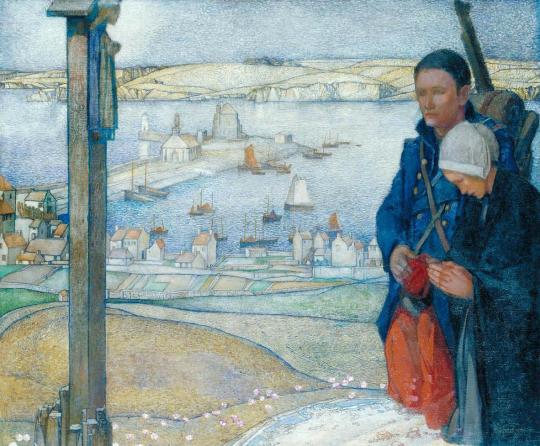
MWW Artwork of the Day (4/19/24)
Edward Reginald Frampton (British, 1872–1923)
Brittany: 1914 (c. 1920)
Oil on canvas, 76.8 x 92.6 cm.
The Tate Gallery, London
Frampton’s painting depicts a young soldier and his companion kneeling to pray at a wayside shrine before he goes off to war. He wears the uniform of a private in the French infantry. The background of the picture depicts a section of the Breton coastal landscape at Camaret-sur-Mer where the artist had spent some time in 1911. Painted in 1920, the work looks back to a moment of innocent patriotism, but is infused with the subsequent knowledge of the horrific loss of life in the First World War.
5 notes
·
View notes
Text

MWW Artwork of the Day (4/18/24)
Marinus Claeszon van Reymerswaele (Flemish, 1495-1567)
Two Tax Collectors (c. 1540-50)
Oil on panel, 82 x 56 cm.
National Museum, Warsaw
There are about thirty versions of the "Tax Gatherers" (the best is in London, National Gallery; another has the date 1552), and what nobody has so far explained is why so many people should want to own a picture of tax collectors (and excessively ugly ones at that) gloating over their imposts. Little is known about the painter except that he worked in the Spanish Netherlands (Flanders), that his works were not many, and that he limited himself to themes better-known through his more productive contemporary, Quentin Metsys. The Prado in Madrid, where one can view this canvas, is the best place to visit if you're interested in the Flemish art of this period.
4 notes
·
View notes
Text

MWW Artwork of the Day (4/17/24)
Late Medieval England (14th-15th c.)
Resurrection (c. 1450-90)
Alabaster sculpture, with traces of paint, 49.5 x 27.9 x 5.9 cm.
Walters Art Museum, Baltimore MD
In the fourteenth and fifteenth centuries, alabaster was a popular sculptural material in England, where it was in plentiful supply. This dramatic panel showing the moment of Christ's Resurrection exemplifies the detail and texture that could be achieved by sculptors working in alabaster. In this exquisitely refined carving, even very shallow relief can suggest a decided sense of depth by depicting overlapping forms. The soldiers in front are in front of the open tomb, which is in front of other sleeping soldiers. The figure of the risen Christ is carved with such subtlety that even the fabric of his mantle appears soft. As Christ steps from the tomb, his foot rests so gently on the sleeping soldier that he doesn't even wake.
11 notes
·
View notes
Text
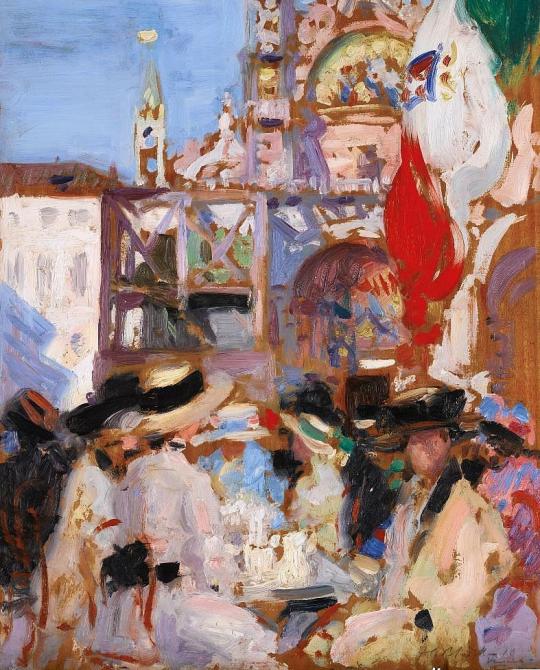
MWW Artwork of the Day (4/16/24)
Francis Campbell Boileau Cadell (Scottish, 1883-1937)
Florian’s Café, Venice (1910)
Oil on panel, 45 x 36.8 cm.
Private Collection
Cadell’s paintings captured the elegance of the Edwardian era; here we see a group of ladies gathered in fashionable attire. Just as café society had fascinated the artists of the Belle Époque, Cadell was drawn by the tumultuous riot of colourful fabrics, décor and the elegant silhouettes of the customers. From his viewpoint before the sun-bathed café terrace, Cadell captures the swirling movement of the busy square; an Italian flag in flashes of bright red and green sweeps down from the top right hand corner of the picture, fluttering above the diners’ hats, the distinctive ornate façade of St. Mark’s Basilica beyond.
3 notes
·
View notes
Text

MWW Artwork of the Day (4/15/24)
Enrique Serra y Auqué (Catalan, 1859-1918)
On the Terrace (1882)
Oil on canvas, 122 x 215 cm.
Private Collection
Depicting a dancer on tiptoe, performing before musicians and her mistress, herself holding a baglama while an African servant fills a small brazier, this dynamic and exotic scene unfolds on a roof terrace beyond which can be glimpsed the roofline of an Eastern city. Captured in virtuoso detail are vibrant carpets decorating a low, tiled wall; these surround eight oranges arranged in a circle around an incense burner at the center of the dance. While the costumes and props are closely observed, the scene is most probably imagined. Whether it depicts a quiet corner of a harem, or a private home, the leisured lady in question sits in comfort being entertained by what appears to be a travelling troupe of musicians and their dancer.
4 notes
·
View notes
Text

MWW Artwork of the Day (4/14/24)
Carl Larsson (Swedish, 1853-1919)
Karin by the Shore Karin vid stranden
Watercolor on paper, 54.3 x 75 cm.
Konstmuseum, Malmö
Carl Larsson has portrayed his wife Karin walking in a pensive pose on the shores of Sundborns river in this watercolor, published in "On the Sunny Side" 1910. There, he writes in his own words on it: "On the second picture Karin walks along the shore and look wistfully at the autumns very last flower. The next night they froze away!" It is their daughter Brita sitting in the rowboat out on the river, dressed in Sundborn Costume. As a company, she has the dog Joup-Joup.
2 notes
·
View notes
Text

MWW Artwork of the Day (4/13/24)
Wang Mingyue (Chinese, b. 1962)
Virtual (2019)
Oil on canvas, 160 x 122 cm.
Private Gallery
Wang Ming Yue graduated at the Chinese Central Academy of Fine Arts in 1991. He is a professional oil painter. “Beijing Trends”, an exhibition held by the China Arts Gallery in 1995, featured three of his paintings, “March”, “Red Coral” and “Tibetan Child”. Some of his works were presented in the China Fine Arts magazine and other publications. He has received invitations to exhibit his work in numerous national and international exhibitions. All the artwork presented in “Spirit of Flower Dream” were sold on the first opening day. In 2004, his work “Finding Spring” was presented in “Traveling on the same road”, exhibition on October 15, 2004, and received a lot of media attention.
4 notes
·
View notes
Text

MWW Artwork of the Day (4/12/24)
Edgar Degas (French, 1834-1917)
Portrait of Mlle. Fiocre in the Ballet "La Source" (c. 1867-68)
Oil on canvas, 130.8 x 145.1 cm.
The Brooklyn Museum, New York (Gift of James H. Post)
In this canvas painted for the 1868 Salon, Degas combined, for the first time in his work, the narrative content, large scale, and complexity of history painting with the representation of modern life —- in this instance, the ballet. Degas depicts the famous ballerina Eugénie Fiocre, at center in pale blue, in "La Source," an elaborate production, with exotic costumes and sets, that also included bodies of water onstage and live horses. Painting the dancers at a pause in their rehearsal —- note the cast-off ballet slippers —- Degas captures them at a transitional moment between the imagined place and time of the ballet and the private reveries of the present.
4 notes
·
View notes
Text
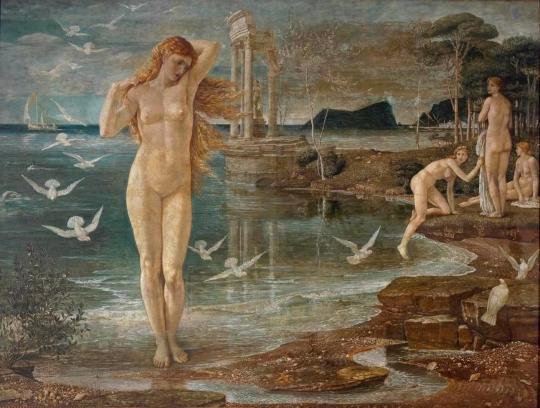
MWW Artwork of the Day (4/11/24)
Walter Crane (British, 1845–1915)
The Renaissance of Venus (1877)
Tempera on canvas, 138.4 x 184.1 cm.
The Tate Gallery, London
Walter Crane was an English artist and book illustrator. He is considered to be the most influential, and among the most prolific, children’s book creators of his generation. Crane's work featured some of the more colorful and detailed beginnings of the child-in-the-garden motifs that would characterize many nursery rhymes and children's stories for decades to come. He was part of the Arts and Crafts movement and produced an array of paintings, illustrations, children's books, ceramic tiles and other decorative arts. Crane is also remembered for his creation of a number of iconic images associated with the international Socialist movement.
18 notes
·
View notes
Text
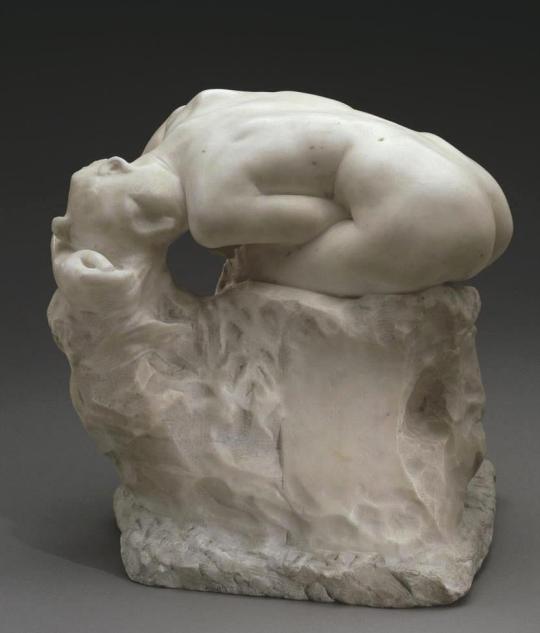
MWW Artwork of the Day (4/10/24)
Auguste Rodin (French, 1840-1917)
Andromeda (1885-86)
Marble sculpture, 29.8 x 29.2 x 22.9 cm.
Rodin Museum, Philadelphia PA (Jules E. Mastbaum Bequest)
In Greek mythology Andromeda is offered as a sacrifice to a sea monster in order to save her father’s kingdom. Chained to a rock to await her fate, she is saved by Perseus, who at first mistakes her for a marble statue. The Rodin Museum owns the first marble version of this subject, made for the French art critic Roger Marx (1859–1913).
0 notes
Text

MWW Artwork of the Day (4/9/24)
Gino Severini (Italian, 1883-1966)
Danseuse (Dancer)(1915)
Oil on canvas, 100 x 81 cm.
Private Collection
A powerful, dynamic and colorful depiction of a figure in motion, "Danseuse" is a quintessential Futurist composition. Central to the Futurists' aesthetic was the idea of movement and speed, and in "Danseuse" Severini translates these notions onto canvas through the figure of the dancer, dissolving it into a vortex of linear trajectories and brilliant color. Here, the artist captured the movements of the dancer through prismatic forms, animating Cubist faceting with the use of a brilliant palette and a dynamic contrast between soft, curved lines and sharp, angular shapes.
5 notes
·
View notes